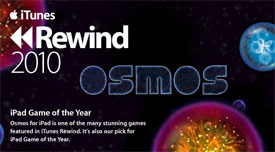Apple's "iPad Game of the Year" was co-developed by computer graphics expert Andrew Nealen
In the computer game Osmos, a player gently nudges an iridescent blue blob through the vastness of space, consuming smaller blobs to gain size and energy while dancing around menacing red blobs waiting to consume it. It’s a simple concept that harkens back to the early days of video games, yet with distinctly modern touches of elegant graphics and dreamy sound tracks.
Perhaps that’s why Apple recently named Osmos its “iPad Game of the Year” for 2010.
Savoring that glory is Andrew Nealen, Rutgers assistant professor of computer science and one of five co-developers of Osmos. A computer graphics expert, Nealen created the game with friends he met a decade ago in graduate school at the University of British Columbia. The first version of Osmos rolled out in 2009 on computers running the Windows operating system. The developers later ported it to run on computers running the Macintosh and Linux operating systems. But the game’s popularity soared when they adapted it to run on Apple’s popular go-anywhere touch-screen devices – the iPod Touch, iPhone and iPad.
Nealen looks back on the team’s successful four-year endeavor with amazement, realizing in retrospect that they did all the right things to develop and market the game. But he’s quick not to claim foresight. He merely acknowledges a lot of hard work and quick decisions along the way that proved fortuitous.
“We started work on iPhone and iPad versions in early 2010,” Nealen said. The developers were almost done with the iPhone version when they made a strategic decision to put it on hold and focus all their attention on Apple’s soon-to-be-released revolutionary iPad tablet device, which made its debut in April of 2010.

Nealen believes that Osmos was one of the first commercial apps customized for the iPad. Other early apps appeared to be iPhone apps “up-sized” to fit the tablet computer’s bigger screen, but not necessarily optimized to use the iPad’s technical capabilities.
A month later, the developers made good on the iPhone version. Each time the game was introduced on a new platform, whether Apple’s handhelds or traditional desktop computers, the team enjoyed a bump in sales.
In the days leading up to Christmas, the game is being offered as part of a bundle of five Windows, Mac and Linux games authored by independent game developers. Customers can pay whatever they feel the games are worth, and they can allocate some or all of their payments to Child’s Play, a charity that gives video games to hospitalized children. While some customers just pony up the dollar minimum, a few have made four-figure payments to get named as top contributors.
“It’s interesting to see how willing people are to give when they can name their prices,” said Nealen. He estimates that Osmos alone grossed $98 thousand in the bundle’s first few days on sale in mid-December.
While enjoying his game’s success, Nealen acknowledges he has to make time for his day job – teaching and doing research on three-dimensional computer graphics. Two of his recent research tools make it easy for computer users to display scientific data or create lifelike 3D models of machine parts and even human faces. One of his tools is now a software component in a larger Disney animation tool.
Because balancing his scholarship and gaming is consuming more hours than he finds sustainable in the long run, he’s trying to make his interests do double duty. He’s applying his principles of gaming – minimalism in design and underlying software code – to his academic research. He is currently writing a book on minimalist game design, and is trying to draw parallels to art, with its minimalist periods.
Still, gaming will always be in his blood.
“I’ve been playing games all my life, and I dreamed about making my own game while I was in grad school,” he said. Not only did he succeed in his ambitions, but those ambitions turned out to be contagious. “Now even some of my students have their own game company.”